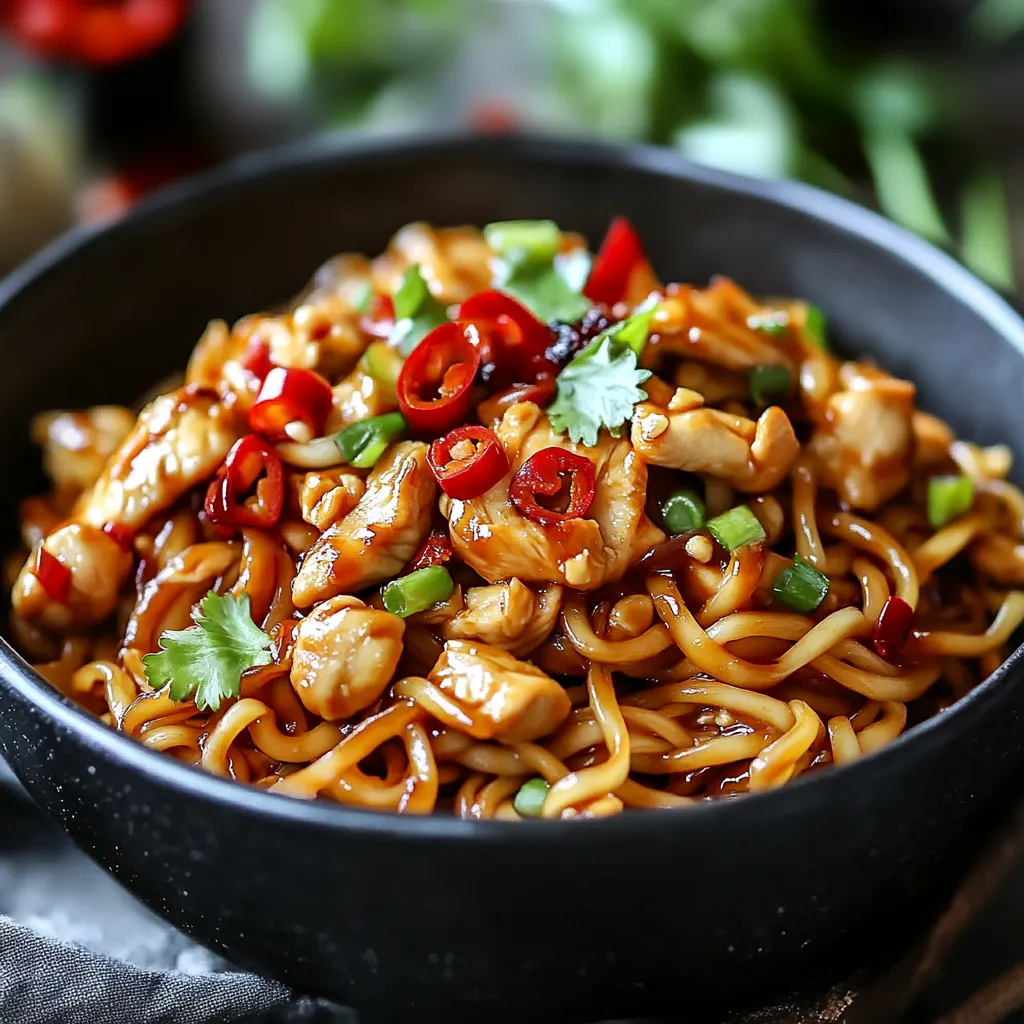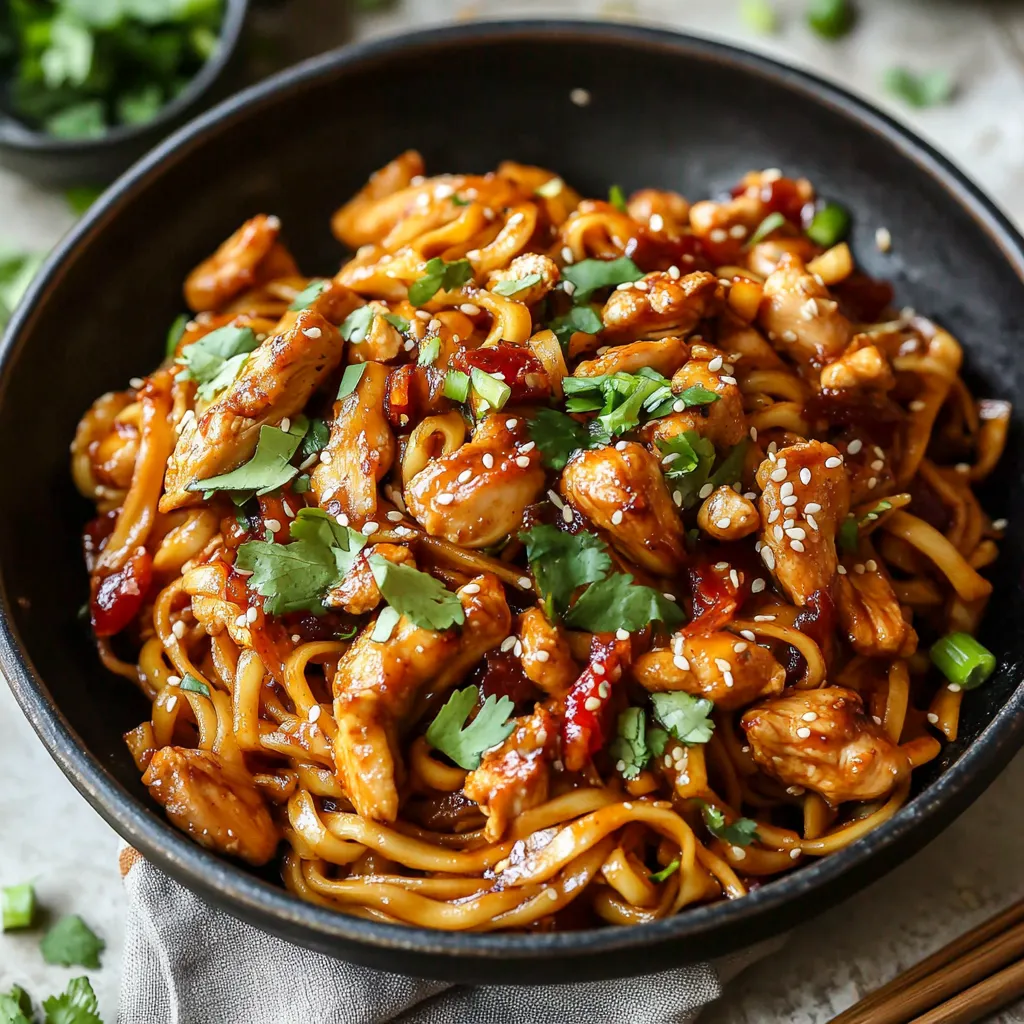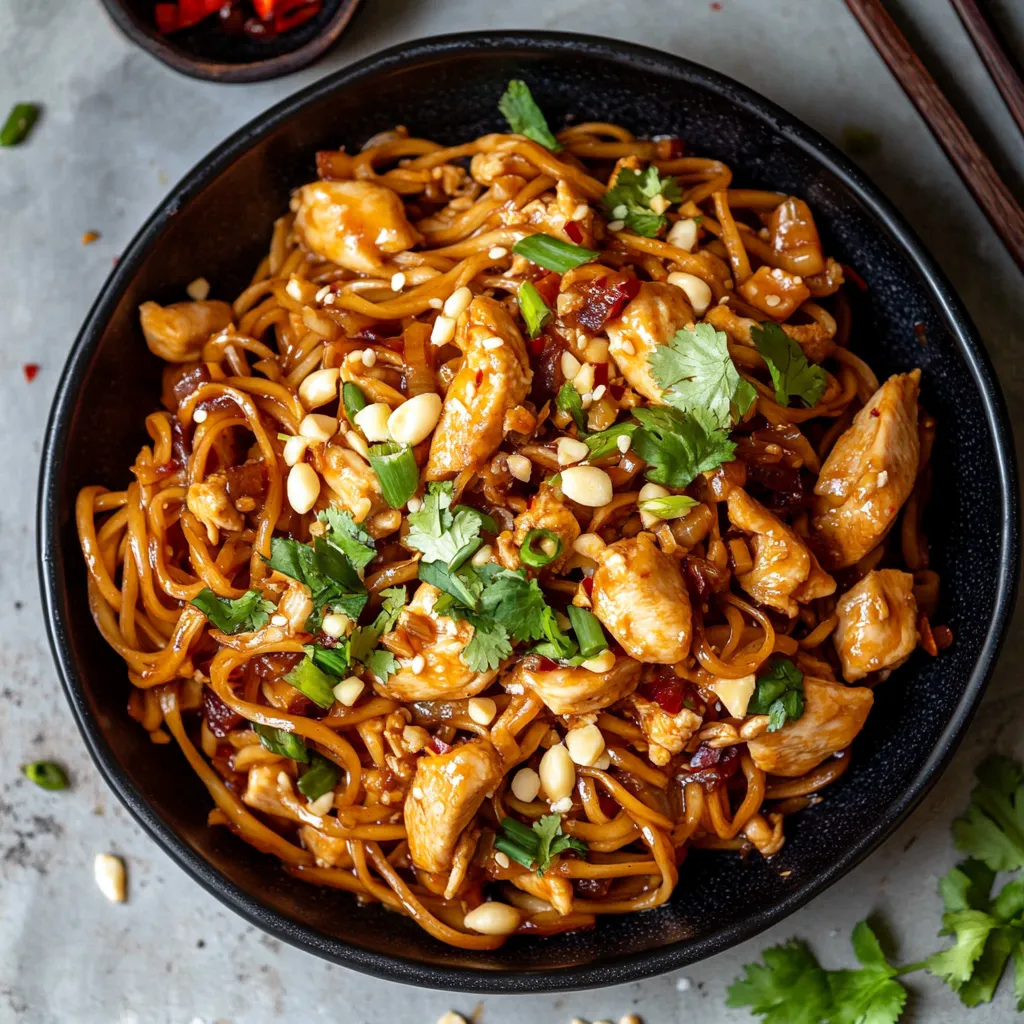 Pin it
Pin it
This hearty Kung Pao chicken noodles recipe has become my go-to dinner solution on busy weeknights. The perfect balance of spicy, sweet, and savory flavors transforms ordinary noodles into a restaurant-quality dish that my family requests at least twice a month.
I first created this recipe when craving takeout but wanting something fresher and healthier. What started as an experiment with ingredients I had on hand has evolved into one of our most requested family meals, especially on evenings when time is tight but we still want something satisfying.
Ingredients
- 12 oz noodles of choice: Use rice noodles for a gluten free option or try udon for a chewier texture
- 1 lb chicken breast: Look for plump pieces without discoloration for the juiciest results
- 3 tbsp low sodium tamari: This provides a rich umami base without overwhelming saltiness
- 1 tbsp honey: Adds just the right touch of sweetness to balance the heat
- 3 tbsp chili paste: Sambel oelek offers authentic flavor but any Asian chili paste works
- 2½ tbsp toasted sesame oil: The nutty aroma transforms the entire dish
- ½ cup diced green onions (white parts): These provide a mild aromatic base for the dish
- 1 tbsp minced garlic: Fresh gives the brightest flavor but jarred works in a pinch
- 1 tbsp peanut butter: Contributes creaminess and authentic Kung Pao richness
- 2 tbsp rice vinegar: Adds brightness and cuts through the richness
- 1½ tbsp brown sugar: Creates caramelization and depth in the sauce
- ¼ tsp ground ginger: Provides warmth without overwhelming the other flavors
- ½ tsp red pepper flakes: Adds pleasant heat that builds gradually
- 3 tbsp water mixed with 1 tbsp cornstarch: Creates the perfect sauce thickness
- ⅓ cup crushed peanuts: Adds essential crunch and authentic finish
- ⅓ cup diced green onions (green parts): Provides fresh pop of color and flavor
Step-by-Step Instructions
- Marinate the Chicken:
- Cut chicken breast into 1 inch pieces for even cooking and maximum flavor absorption. Combine with tamari, honey and chili paste in a bowl, stirring well to coat each piece. Allow to marinate ideally for 12 hours, though even 30 minutes will infuse good flavor. The acid in the marinade begins to tenderize the protein while the sweet and spicy elements penetrate the meat.
- Prepare the Noodles:
- Bring a large pot of water to a rolling boil, adding enough salt to make it taste like seawater. This seasons the noodles from within as they cook. Add noodles and cook precisely according to package directions, stirring occasionally to prevent sticking. Test frequently for doneness as overcooked noodles will become mushy in the final dish. Drain thoroughly but do not rinse to maintain the starches that help sauce adherence.
- Create the Sauce Base:
- Combine tamari, peanut butter, rice vinegar, chili paste, brown sugar, ground ginger, sesame oil and red pepper flakes in a bowl. Whisk vigorously until the peanut butter fully incorporates and no streaks remain. This homogeneous mixture ensures balanced flavor in every bite. The combination creates the signature Kung Pao flavor profile that balances heat, sweetness, acidity and richness.
- Build the Flavor Foundation:
- Heat sesame oil in a large skillet over medium low heat until it shimmers but does not smoke. Add the white parts of green onions and sauté for 2-3 minutes until they begin to soften and become translucent. The gentle cooking releases their sweet flavor while tempering their sharpness. Add minced garlic and cook for exactly one minute more. Watch carefully as garlic burns quickly and will impart bitterness if overcooked.
- Cook the Chicken:
- Add marinated chicken pieces to the aromatic base, discarding any excess marinade which could make the dish too wet. Spread pieces in a single layer and allow to cook undisturbed for 2-3 minutes until golden brown on one side. Flip each piece and cook for another 2-3 minutes until internal temperature reaches 165 Fahrenheit. This method ensures proper caramelization and food safety while preventing the chicken from becoming rubbery.
- Thicken the Sauce:
- Transfer the prepared sauce base to a separate pot over low heat. Warm gently while whisking to maintain smoothness. In a small bowl, create a slurry by thoroughly combining water and cornstarch until no lumps remain. Gradually pour this into the warming sauce while continuously whisking. Allow the mixture to simmer gently for 1-2 minutes until it noticeably thickens and takes on a glossy appearance.
- Combine Components:
- Add cooked noodles directly to the thickened sauce, using tongs to gently toss until every strand is evenly coated. The starch from the noodles will further help the sauce cling properly. Add the cooked chicken along with any accumulated juices from the pan. Fold everything together carefully to maintain the integrity of both noodles and chicken pieces.
- Final Integration and Serving:
- Allow the combined dish to simmer for 1-2 minutes more, which lets the flavors meld together and the noodles absorb some of the sauce. Transfer to serving bowls and generously sprinkle with crushed peanuts and the reserved green parts of the green onions. The contrast of textures and fresh element from the onions elevates the entire dish to restaurant quality.
 Pin it
Pin it
The chili paste is truly the heart of this recipe. I discovered sambel oelek years ago at an Asian market and it completely transformed my home cooking. Unlike sriracha which has garlic and sugar already mixed in, this pure chili paste lets you control every element of the flavor profile. My children were initially skeptical of the red color but now recognize it as the sign of their favorite dinner coming together.
Storage Tips
This dish maintains its quality remarkably well in the refrigerator for up to 3 days. Store in airtight containers, preferably glass which won't stain from the chili paste. The flavors actually continue to develop overnight, making day-two leftovers sometimes even better than the original meal. If you find the noodles have absorbed too much sauce and seem dry when reheating, add a small splash of chicken broth or water when warming. Avoid freezing this dish as the noodles tend to become mushy when thawed.
Making It Your Own
The beauty of this recipe lies in its flexibility. Feel free to substitute the protein based on what you have available. Shrimp cooks even faster than chicken, while tofu requires a bit more attention to develop good texture. Press extra firm tofu for 30 minutes before cubing and consider coating with cornstarch before frying for extra crispness. Vegetable additions work wonderfully too. Bell peppers, snow peas, broccoli, or mushrooms can be added during the last few minutes of cooking. For a lower carb option, reduce the noodles by half and add spiralized zucchini or carrots.
Heat Level Customization
The recipe as written creates a medium spice level that most adventurous eaters will enjoy. For those sensitive to heat, reduce the chili paste to 1 tablespoon and omit the red pepper flakes entirely. The dish will still maintain its characteristic Kung Pao flavor profile through the other ingredients. For true spice enthusiasts, add 1-2 dried Chinese chilies, crushed, or increase the red pepper flakes to a full teaspoon. Remember that the heat builds as the dish sits, so leftovers will typically taste spicier than when first served.
 Pin it
Pin it
With a little planning, this Kung Pao chicken noodles recipe will become your family’s go-to, delivering restaurant-level indulgence right at home.
Frequently Asked Questions
- → Can I make Kung Pao Chicken Noodles less spicy?
Absolutely! To reduce the spiciness, simply decrease or omit the red pepper flakes and use less chili paste in both the marinade and sauce. You can adjust these elements to your preferred heat level without sacrificing the dish's signature flavor.
- → What type of noodles work best for this dish?
You can use various noodles including rice noodles, egg noodles, udon, or even spaghetti. Rice noodles keep the dish gluten-free when paired with tamari. Choose thicker noodles if you prefer more chew, or thinner ones for a lighter texture.
- → Can I add vegetables to this Kung Pao dish?
Yes! Broccoli and bell peppers work wonderfully as mentioned in the instructions. Other great additions include snap peas, carrots, zucchini, or water chestnuts for extra crunch. Add them when sautéing the chicken or stir in pre-cooked vegetables at the end.
- → Can I substitute the chicken with something else?
Certainly! Tofu, shrimp, or beef work well as protein alternatives. For vegetarian versions, use extra-firm tofu or increase the vegetables. Just adjust cooking times accordingly—shrimp cooks faster while beef might need a few extra minutes.
- → How can I store leftover Kung Pao Chicken Noodles?
Store leftovers in an airtight container in the refrigerator for up to 3 days. When reheating, add a splash of water or chicken broth to revitalize the sauce, as noodles tend to absorb liquid during storage. Reheat gently on the stovetop or microwave until just hot.
- → Is there a substitute for peanut butter in the sauce?
Yes, you can substitute peanut butter with almond butter, sunflower seed butter, or tahini for those with peanut allergies. Each alternative will slightly alter the flavor profile but still create a delicious sauce. For a nut-free version, try tahini with a touch more sesame oil.
